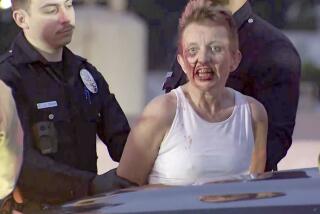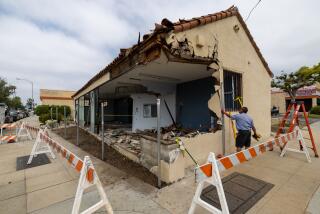Freeway Complaint Was Almost Fatal for La Mesa Driver
- Share via
The rented black Chevy Cavalier came out of nowhere, lurching across all four lanes of northbound Interstate 5 in Del Mar like a high-speed shoelace threading a shoe.
Bradley Steele remembers the driver well, his wiry frame and a baseball cap worn backward. But it was the reckless driving that struck him most--how the sedan ventured onto both shoulders to pass cars. And how it barely missed driving Steele’s Volkswagen Rabbit right off the road.
“My girlfriend thought we should write down his license number,” Steele recalled of the Sunday afternoon incident. “But I said, ‘No, maybe he’s on his way to the hospital or something.’ That’s the way I am.”
When Steele pulled off the freeway, to the end of the circular exit ramp at Via de la Valle, however, he spotted the black sedan with the rent-a-car sticker sitting in front of him.
That’s when the 29-year-old La Mesa drywaller decided to have a word with this reckless driver. It was a snap decision that made Steele another kind of statistic--a victim of the continuing waves of freeway violence in Southern California.
But Steele was lucky, because his story has a third main character: a passerby who saved his life.
Shortly before 3 p.m., Steele stepped out of his car and approached the motorist, saying, “Hey, don’t you think you better watch how you’re driving?”
The answer was an 8-inch hunting knife, which the motorist wielded, severing Steele’s femoral artery, in the groin area. His attacker stabbed him six more times in the back and chest as Steele struggled helplessly, face-down on the street.
Then, as the occupants of a dozen other vehicles at the red light looked on in horror--behind closed windows and locked doors--the motorist and a woman companion sped off, leaving a bleeding Steele for dead.
But, as Steele’s girlfriend, Barbara Lay, screamed in panic, a visiting Santa Ana cardiologist in search of a restroom for his two young children took the emergency steps that saved a man’s life.
Dr. Jerrold Cantor immediately stuck his hands inside the wound to stop the pulsating blood flow from Steele’s groin and the numerous gashes in his back until paramedics arrived.
“That doctor saved my life, there’s no doubt about it,” Steele said Tuesday from his bed at Scripps Memorial Hospital in La Jolla. “Some crazy guy tries to kill me, and then he comes along and says, ‘I’m a doctor and I can help you.’
“He stuck his hands right in the wound to step the bleeding. And he told the paramedics exactly what was wrong with me so we didn’t waste time. If he hadn’t come along, I don’t think I would have survived.”
Three years after the scary summer of 1987, when California freeways made national headlines as a place where armed and outraged motorists unleashed their wrath on each other, freeway violence continues to plague San Diego County and elsewhere.
In August, as his father watched helplessly from a trailing car, 19-year-old Armando Gill was killed when a car pulled up alongside his pickup on Interstate 805 near downtown and fired two shotgun blasts at his head.
Last month, two San Diego teen-agers were shot to death on I-805 by an assailant who riddled their car with bullets.
And last week, a motorist was shot in killed as he drove along the I-405 freeway in Orange County, according to CHP officers.
Since 1987, the California Highway Patrol has received thousands of reports statewide involving gunshots, brandished weapons, fistfights, egg and rock throwing and rammed vehicles along busy traffic arteries.
“We get more than 50 freeway-violence reports a month from San Diego and Orange counties alone,” said Officer John Marinez, a CHP spokesman. “It’s a real problem because the numbers remain consistent. And we’ve put more officers on the road because of it.”
Authorities offer many explanations for the violence. American society increasingly condones violence, they say. And cars offer anonymity, a feeling of power and a chance to escape, lowering inhibitions to aggression.
Also, specially in Southern California, rush hour has turned into creep hour, raising drivers’ frustrations and blood pressures. Inevitably, something snaps.
“We all face it every day,” said Bill Robinson, a spokesman for the San Diego Police Department. “People flip each other off, and sometimes it gets more violent. . . . While it’s sometimes difficult advice to follow, the best thing to do is clench your teeth and stay inside your car.”
For Bradley Steele, about as far as he thought of freeway violence was tapping his brake lights in defiance of drivers who blind him with their high beams.
But, even in five years driving 18-wheel tractor trailers he never gestured at any driver who cut him off. None of that violent stuff was going to happen to him.
“This is not something I planned on happening,” he said. “Unfortunately, I look at others like I look at myself. And I don’t have a rage inside me that would make me want to kill someone over a traffic disagreement. I guess I was wrong about this guy.”
All too quickly, he recalled, a Sunday afternoon trip to a ski equipment show at the Del Mar Fairgrounds, turned decidely ugly.
“I would never have done that if I was downtown or in Chula Vista or something,” said Steele, a muscular man who one day wants to become a firefighter. “But I was in Del Mar, not the scroungy part of town.”
Steele insists he didn’t provoke the driver after he whizzed past him on the freeway. He thought the guy was a young tourist, and he just wanted to tell him to slow down while visiting San Diego.
As he stepped from his car, he remembers the motorist eyeing him through his side-view mirror. Then, without saying a word, the guy jumped out and walked quickly toward him.
“It was like he was in a rage, sort of,” Steele recalled. “He didn’t say anything. He just kept coming like he was going to walk right through me.”
As Steele put up his hands in defense, the man brought the knife up from behind him, slashing the femoral artery. “I felt this thick feeling, like something that’s in your body that isn’t yours,” he said. “Then I got all warm and wet.”
Steele recalls seeing the faces of the occupants of nearby cars, looking on as the man stood over him, stabbed repeatedly. Finally, he yelled out. “I’ve been stabbed.”
As a friend in a trailing car arrived to help, the motorist sped off. It was only then that people left their cars to look after him, Steele recalled.
“I really didn’t expect anyone to get out of their cars,” he said.
“Here’s this guy wielding this big knife against a total stranger. And they’re supposed to get out and tell him to stop?”
Police later found the bloodied knife a short distance away and are still searching for the man.
Dr. Jerrold Cantor remembers the black sedan cutting off cars on the freeway. But he didn’t witness the stabbing. The Orange County cardiologist was too busy looking for a restroom during a weekend visit to San Diego.
That’s when he saw Steele sprawled by the roadside, blood pouring from his groin. He remembers Steele’s girlfriend screaming something about him dying as Steele sat silently in the road.
Then he went to work covering the holes in a dying man’s body while his wife called for help on their cellular phone. With the help of a medical intern who also happened upon the scene, Cantor kept Steele alive until paramedics arrived 10 minutes later.
“I knew that if I didn’t get him to lie on his side and stop the bleeding from the femoral artery, he was going to die,” Cantor said.
Cantor, 46, had never seen someone outside a hospital so close to death.
“This is what you train for,” he said. “This is what medicine is all about.”
The incident, however, has given Cantor pause over the continued specter of freeway violence.
As he drove home, his shirt and pants still covered with blood, he fielded a barrage of questions from his children, aged 6 and 8. “They wanted to know why people stabbed each other,” he said.
“I told them that, when you drive a car, you can’t take things personally. You can’t hold grudges. And I told them how it was important to help people in need, to do the kinds of things you’d like someone to do for you one day.”
Cantor’s children weren’t the only ones shaken up over the incident. So was he.
“It makes you wonder what’s going on out there,” he said. “Someday, your kids will be out there on the road, and they don’t understand this kind of behavior. I hope they never have to.”
Steele is sure of one thing. That’s the last time he’s going to get out of his car to confront another driver--for any reason. For now, though, he’ll stay in his hospital bed, recovering from the stab wounds that doctors say almost made him a paraplegic.
“I think I had a real bad piece of luck,” he said, shaking his head. “When you think about about how many people are out there driving.”
Then he stopped himself.
“If I’d known I was going to run into him, I would have stayed home and gotten the flu or something.”
More to Read
Sign up for Essential California
The most important California stories and recommendations in your inbox every morning.
You may occasionally receive promotional content from the Los Angeles Times.














